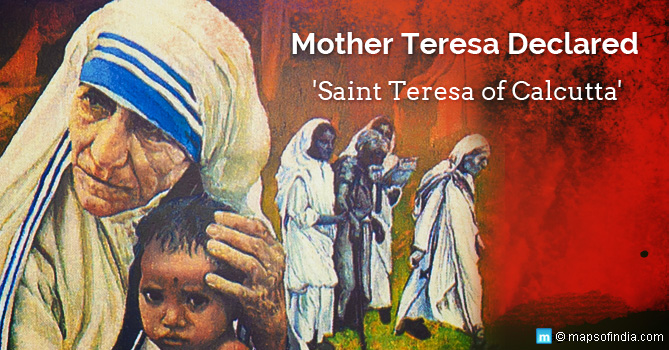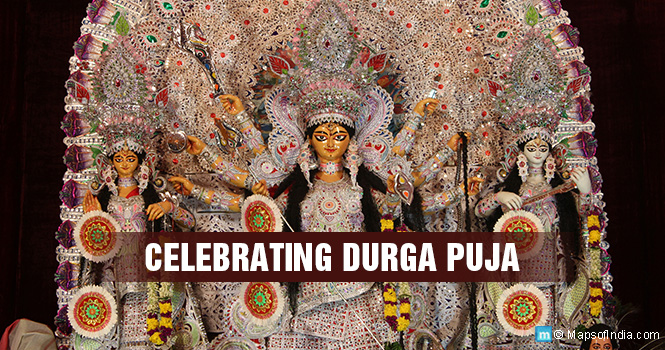
On Sunday, September 4, 2016, Pope Francis conferred the honour of sainthood on Mother Teresa. This is one of the highest honours that the Catholic Church is allowed to bestow on an individual. Known as “saint of the gutters”, Mother Teresa — who made Kolkata her spiritual home — was heaped immense praise by Pope for the way she dedicated herself to uplifting the condition of people rejected by the society – the so-called outcasts.
He also lavished praise on her for the way her work created a sense of shame among the global leaders for the poverty that they had created with their actions. Pope Francis also praised her for the way she changed the church into a hospital, to help those who were suffering from both spiritual and material poverty, and those suffering from basic existential problems.
How did it all happen?
The canonization ceremony took place at St. Peter’s Square, where around 120,000 people assembled in order to bear witness to the day-long proceedings. However, when Mother Teresa was beatified in 2003 there were more than 300,000 people present at the celebrations organized by St. John Paul II, who was keeping ill at the time. The low turnout was attributed to the deteriorating financial and security condition in Europe.
In fact, there was such trepidation that the event saw a security force of 3000 law enforcement officials manning the grounds as well as the airspace. In spite of the supposedly-reduced audience, the event could be regarded as the focal point of the Holy Year of Mercy, orchestrated by Pope Francis and also known as the Jubilee Year. The ceremony could also jolly well be regarded as one of the high points of his papal reign that has focused so much on the aspect of mercy.
Jubilee Year was supposed to come to an end during November. The security arrangements – at least most of them – were to remain in place up until that duration.
Area of emphasis for Pope Francis
As a religious leader, Pope Francis himself has always been devoted towards serving the people largely marginalized by society, like prostitutes, prisoners, refugees, homeless people, and the like. It is, perhaps, in such a vein that a connection can be established with Mother Teresa being canonized as St. Teresa of Kolkata. It is basically celebrating her life and work and also affirming the areas that have been prioritized by Pope Francis.
Incidentally, Pope Francis has earned both bouquets and brickbats for this. However, he has clearly modelled himself on Mother Teresa. He lives a simple life and serves poor selflessly. He does not stay at the Apostolic Palace meant for someone of his stature, instead preferring to stay at a room in a hotel meant for refugees. In an age when personal gratification and complete disregard for the unborn, old, and poor is the order of the day, this is something to be celebrated rather than questioned.
Homily to Mother Teresa
He also lauded her for the way she defended people who were abandoned and sick. Mother Teresa was a staunch opponent of abortion and, as a result, she was opposed by progressive people from around the world. This spirit was also congratulated by Pope Francis. He praised her for the way she dedicated her life towards people who were spent and had been left to wither away on roadsides.
According to Pope Francis, she did this because in them she saw the dignity bestowed by divinity. He has also confessed to being intimidated by Mother Teresa because of her reputation as a tender and tough person. When he had visited Albania in 2014, he had stated that he would never want to work under Mother Teresa because of her firmness. However, he also said during the ceremony that, considering her maternal nature, she would always be fondly remembered as Mother Teresa rather than St. Teresa. In his homily, Pope Francis also called upon people to be pleasant in their hearts and extend that feeling to others whom they meet in this journey, especially the ones that are suffering.
Life of Mother Teresa
Mother Teresa was born on August 26, 1910, as Agnes Gonxhe Bojaxhiu. She arrived in India in 1929 as a sister belonging to the Loreto Order. It was in 1946 that she admittedly got the divine call that asked her to come to Kolkata (then Calcutta) and tend to ones that were not wanted or loved, and those that were at the very bottom of the social heap. She established Missionaries of Charity, a sisterhood of nuns dedicated to this aim. It became one of the most prominent names of its kind across the world.
Missionaries of Charity had around 4000 sisters, all of whom wore the trademark white saris with blue borders. They worked as per Mother’s instruction to perform “small things with great love”. It has also become a global order with nuns, brothers, priests, and co-workers, who are basically ordinary people. She received the Nobel Prize in 1979. After her death, the process of her sainthood was prioritized by St. John Paul II.
Dark revelations
It is said that she spent the majority of her adult life in a significant amount of spiritual duress. She always felt that God had left her. This is why Pope Francis’ emphasis on her being a symbol of vivacious dedication towards the uplift of the poor is so discordant. After she passed away in 1997, it was revealed that she experienced a period of profound self-doubt, loneliness, and despair. This is known in religious parlance as dark night of the soul and is common to many mystics that have attained greatness later on. For Mother Teresa, this went on for 50 years, which is absolutely unheard of.
Reverend Brian Kolodiejchuk from Canada led the campaign to crown Mother Teresa as a saint. He felt that these revelations only show how deserving Mother Teresa was of Sainthood since she also shared the material and spiritual ailment of the ones that she served. In his homily to Mother Teresa, Pope Francis may not have mentioned this aspect of her life.
Reception back in Kolkata
The Mass of canonization was streamed live and was watched by hundreds of people at the Mother House in Kolkata. They burst onto claps when Mother was canonized as a Saint. On the day her tomb was decorated with a photo of her in the later stages of her life, a candle, and many flowers. People in attendance expressed their pride at being able to witness the historic event unfold and at the recognition being granted to Mother Teresa.
Criticism of Mother Teresa – Church’s reaction
Christopher Hitchens has till date been the most vocal critic of Mother Teresa. He has accused her of having taken money from dictators. This is one accusation that the authorities of the Catholic Church have kept on denying. Instead, Pope Francis has opted to dwell on her other work done with the powerful names of the world. People have also questioned the expenses made by her order and brought allegations of medical negligence. Critics have complained that people in her homes lived in horrible conditions and there were many instances of poor treatment. They have also questioned the very basis of her sainthood – the miracles that she supposedly performed.
Missionaries of Charity at the function
The ceremony was attended by hundreds of sisters from Missionaries of Charity. There were also 1500 homeless people in attendance along with members of royalty such as Queen Sofia from Spain and 13 heads of state. There were people from as far as Gabon in order to attend the Mass. Pope Francis hosted a lunch for the homeless people at Vatican Auditorium after the proceedings concluded. The food was supplied by a pizza maker from Naples, who came armed with his own ovens for the event.
Related Link:




